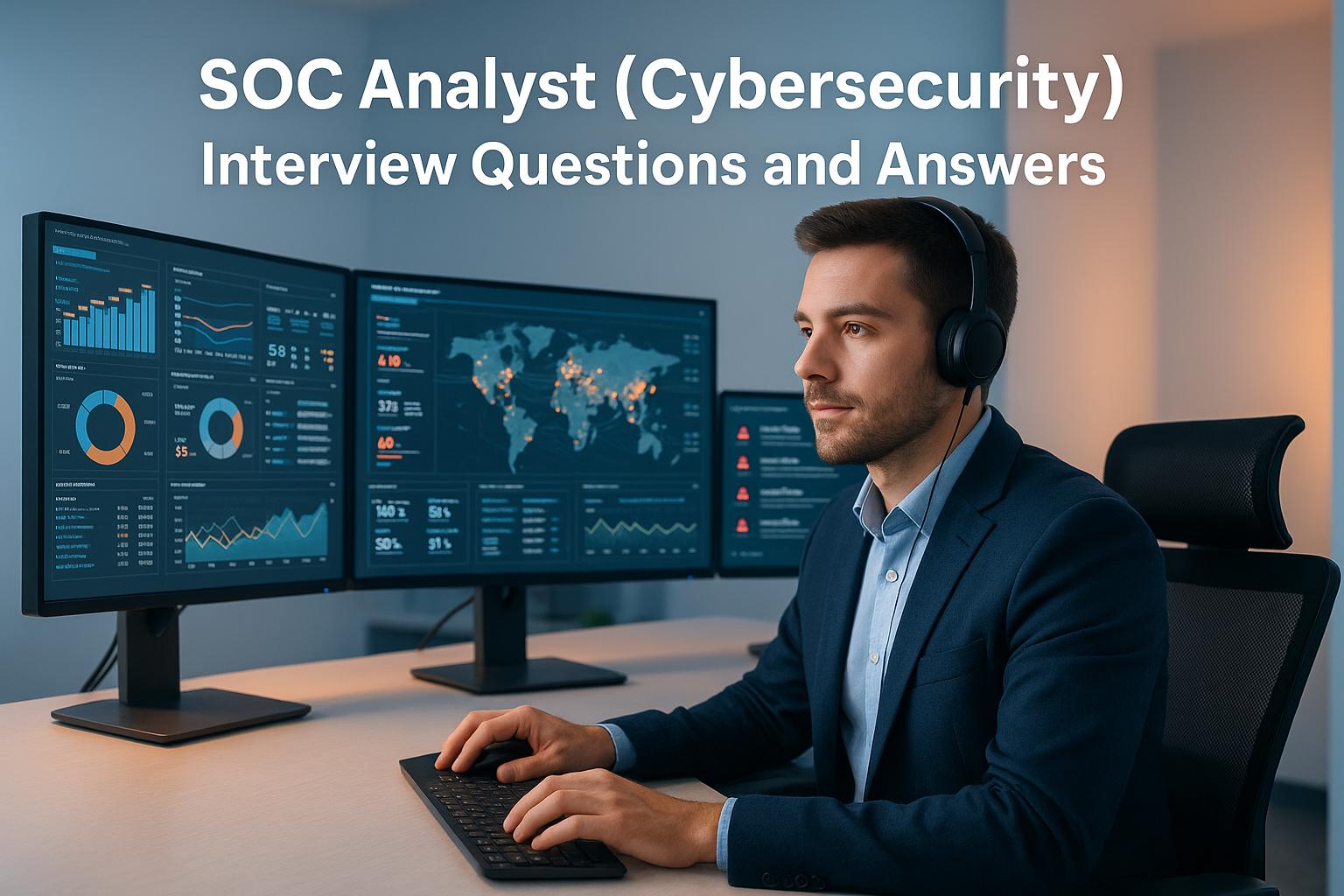Breaking into cybersecurity can be tough, especially with no prior experience. But with the right resume, you can stand out. Here’s what you need to know:
- Cybersecurity is booming: Jobs for information security analysts are projected to grow by 32% from 2022 to 2032, with entry-level salaries ranging from $55,000 to $85,000 annually.
- Your resume matters: Employers value technical skills, certifications, and hands-on projects over work history. Tailor your resume to highlight these.
- Key sections: Include contact details, a professional summary, education, certifications, technical skills, and relevant projects.
- Formatting tips: Use a clean, polished layout, stick to one page, and focus on measurable results.
- Avoid common mistakes: Skip unrelated experience, avoid vague descriptions, and balance technical terms with clear language.
This guide will help you craft a resume that showcases your skills, certifications, and potential, even if you're just starting out in cybersecurity.
TOP 5 MUST HAVES in an Entry-Level Cybersecurity Resume
Required Sections for an Entry-Level Cybersecurity Resume
When crafting a resume for an entry-level cybersecurity role, focus on sections that effectively highlight your qualifications and potential.
Contact Information
Start with your contact details at the very top. Include your full name, phone number, professional email address, and an up-to-date LinkedIn profile. You can also add your mailing address or at least your city and state. Make sure your LinkedIn profile is polished and aligned with your career goals. Right below this, grab attention with a strong professional summary.
Professional Summary
Follow your contact information with a brief 2–3 sentence professional summary. If you're just starting out, focus on your enthusiasm for learning, your technical skills, and your potential to grow in the field rather than a lengthy work history.
Use job-specific keywords to make your summary stand out. Mention certifications, technical expertise, and any hands-on projects or internships that are relevant. Tailor this section for each job application by incorporating skills and keywords from the job description. Here are two examples to guide you:
Recent cybersecurity graduate with CompTIA Security+ certification and hands-on experience in penetration testing. Created a machine learning-based intrusion detection system during an internship, reducing false positives by 30%. Skilled in Python, network security, and cloud security concepts.
Entry-level cybersecurity analyst passionate about threat intelligence and incident response. Completed a capstone project on AI-driven malware detection, achieving 95% accuracy. Proficient in SIEM tools, vulnerability assessment, and familiar with the NIST cybersecurity framework.
Education
Clearly list your academic background, including your degree, major, institution, and graduation date. If you recently graduated with a GPA of 3.5 or higher, include it. Highlight coursework that directly relates to cybersecurity, such as Network Security, Ethical Hacking, Digital Forensics, or Cryptography.
If you're transitioning from another field, emphasize any cybersecurity-specific training programs, bootcamps, or certifications you've completed. Showcase transferable skills like problem-solving and analytical thinking that align with cybersecurity roles.
Certifications
Certifications are a powerful way to demonstrate your expertise, especially for entry-level candidates. List them in reverse chronological order, including the certification name, issuing organization, and date earned.
For example:
- CompTIA Security+: Validates core security knowledge and is often the first certification recommended for cybersecurity professionals.
- Certified Ethical Hacker (CEH): Highlights skills in penetration testing and ethical hacking.
- Microsoft Security, Compliance, and Identity Fundamentals: Focuses on enterprise-level security management.
"The first security certification a candidate should earn. It establishes the core knowledge required of any cybersecurity role and provides a springboard to intermediate-level cybersecurity jobs." – CompTIA Website
If you're aiming for government roles, consider certifications that meet U.S. Department of Defense requirements. After establishing your certifications, move on to detailing your technical skills.
Technical Skills
This section is where you highlight your practical abilities and familiarity with tools and technologies used in cybersecurity. Organize your skills into categories for clarity, such as:
- Security Tools: Wireshark (network analysis), Splunk (log management), Metasploit (penetration testing), Nessus (vulnerability scanning)
- Programming Languages: Python (automation), PowerShell (Windows environments), SQL (database security)
- Operating Systems: Linux distributions commonly used in cybersecurity, Windows Server
- Frameworks: NIST, ISO 27001, OWASP
Only include skills you can confidently demonstrate in practice. This section is your opportunity to showcase your technical readiness for the role.
Formatting and Style Guidelines
The way your resume looks can significantly influence the impression you make on hiring managers. A polished, well-structured resume not only highlights your professionalism but also demonstrates attention to detail - an essential trait in cybersecurity. Plus, a clear format ensures your qualifications are easy to read and understand.
Clean and Professional Layout
Stick to simple, easy-to-read fonts like Arial, Calibri, or Times New Roman, sized between 10 and 12 points. Fancy or decorative fonts can be distracting and may even cause issues with Applicant Tracking Systems (ATS). Keep the body text uniform in size and use consistent styling for headers.
To create a clear visual structure, make section headers bold and slightly larger than the body text. Add enough white space between sections to avoid a cluttered look, and maintain consistent margins - typically between 0.5 and 1 inch - on all sides.
Avoid complex layouts, text boxes, or graphics that could confuse ATS software. Stick to standard bullet points instead of special symbols, which might not be interpreted correctly by these systems.
Pair this clean layout with a reverse chronological format to ensure your most recent skills and experiences are immediately visible.
Reverse Chronological Format
Organize your resume by listing your most recent experiences first, working backward in time. This reverse chronological format is particularly effective for cybersecurity roles, as it emphasizes your latest and most relevant qualifications.
This format is also ATS-friendly, making it easier for software to scan and for hiring managers to quickly spot your most recent and applicable experience. For instance, if you recently completed a cybersecurity internship but also held an unrelated job in the past, the internship should take priority. Always put job-related experience at the forefront.
One-Page Limit
For early-career professionals in cybersecurity, keeping your resume to a single page is essential. This forces you to focus on your strongest qualifications while respecting the time constraints of recruiters, who often sift through hundreds of resumes.
Andrew Golden, Lead Technical Recruiter at Trellix, offers this reassurance:
"Everybody from zero years' experience to 35 years' experience struggles with this. You are not alone!"
Make every line count by keeping introductions brief and emphasizing measurable accomplishments. Tailor your resume to each job by incorporating keywords from the job description and highlighting the most relevant parts of your background. This targeted approach increases your chances of landing an interview.
For additional details about your experience, consider expanding your LinkedIn profile. This allows you to maintain a concise resume while still showcasing your full qualifications.
sbb-itb-8a31326
Key Cybersecurity Skills and Experiences to Include
To make your resume stand out, it's important to highlight a well-rounded mix of technical expertise, interpersonal abilities, and practical experience.
Technical Skills
The technical skills section of your resume should reflect your ability to tackle cybersecurity challenges effectively. Showcase your scripting knowledge, particularly with Python and PowerShell, as these are essential for automating tasks and handling incident response scenarios.
Mention your experience with industry-standard frameworks like NIST, ISO, CIS, and SOC 2, which demonstrate your understanding of compliance and best practices. Highlight your proficiency with tools and technologies such as SIEM, IDS/IPS, firewalls, VPNs, network segmentation, traffic analysis, and your ability to work across different operating systems like macOS, Windows, and Linux.
Cloud security skills are especially sought after and can add significant value to your profile. In fact, professionals with expertise in cloud security often earn an additional $15,000 annually. As Steve Graham, Senior Vice President at EC-Council, emphasizes:
"You're going to see a critical eye [from employers], especially on the technical piece, on the ability to do the job. We also need leadership and management roles, that are aware of the kind of cyber threats and the liabilities around them."
To showcase your technical expertise, include certifications or highlight relevant projects that demonstrate your skills. Pair these with strong interpersonal abilities to show you can effectively communicate and collaborate within a team.
Soft Skills
Soft skills are just as important as technical know-how in the cybersecurity field. In fact, 54% of security professionals in a recent survey pointed to gaps in communication and problem-solving skills as a major issue in the current workforce.
Clear communication is critical, especially when explaining technical security concepts to non-technical stakeholders. As Elizabeth Khan, a Cybersecurity Auditor at St. Luke's Boise Medical Center, advises:
"Use analogies and simplify jargon for non-technical audiences. The ability to simplify concepts or make them relatable with analogies or metaphors is very valuable when communicating."
Problem-solving and critical thinking are also key, helping you analyze threats and develop effective security strategies. Show that you're adaptable and committed to lifelong learning by mentioning seminars, certifications, or hands-on training sessions you’ve completed. Platforms like LinkedIn are great for showcasing these achievements.
Additionally, emphasize your ability to stay calm under pressure, a crucial skill when managing high-stress situations like security breaches. Teamwork and collaboration are equally important, as cybersecurity professionals often work closely with IT teams, management, and external partners during both routine operations and emergencies.
Project Experience
Practical, hands-on experience is one of the best ways to demonstrate your cybersecurity skills. Highlight specific projects that show your ability to handle real-world challenges, even if they were part of academic coursework or personal initiatives.
Participating in Capture the Flag (CTF) competitions is a great example. These events allow you to solve security puzzles, identify vulnerabilities, and showcase your technical expertise in realistic scenarios. Security research projects, such as vulnerability analysis, malware studies, or building security tools, are also worth including.
Academic projects, like penetration testing exercises, network security simulations, or incident response drills, demonstrate both your structured learning and practical application of skills. Additionally, personal projects - such as setting up a home lab, configuring security tools, or writing security scripts - highlight your initiative and problem-solving abilities.
When describing your projects, focus on the technologies you used, the challenges you faced, and the outcomes of your work. For example, quantify your achievements by mentioning the number of vulnerabilities you identified or systems you secured. These specific details make your experience more compelling and give potential employers a clear sense of your contributions.
Common Mistakes to Avoid
When crafting a resume for a cybersecurity role, even small missteps can make a big difference. To ensure your resume stands out and effectively showcases your potential, steer clear of these common errors.
Leaving Out Relevant Projects
One major misstep for entry-level candidates is including unrelated work experience. Recruiters in cybersecurity care more about your relevant skills and projects than roles in areas like front-end development or chip design. Instead of padding your resume with unrelated jobs, focus on showcasing cybersecurity-specific projects and accomplishments.
For instance, academic projects can be a game-changer. Highlight coursework that involved penetration testing, network security simulations, or incident response exercises. Personal projects are just as impactful - mention setting up a home lab, configuring security tools, or creating custom scripts for security purposes.
If you’ve participated in CTF competitions or conducted independent security research, make sure to include those too. When describing your projects, emphasize the tools and techniques you used. For example, if you’ve worked with tools like Kali Linux for penetration testing, Wireshark for analyzing networks, or Splunk for log analysis, list them prominently. This aligns your resume with the skills recruiters are actively seeking.
Using Generic Descriptions
Vague descriptions can dilute the impact of your resume. Instead of generic phrases like "handled network security", aim for action-driven, precise language that highlights your contributions and results. A common mistake is failing to quantify achievements. For example, rather than saying you "performed vulnerability assessments", you could write, "identified and documented 15 critical vulnerabilities using Nessus, resulting in a 40% improvement in network security."
Active voice can also make your resume more dynamic and engaging. Swap out passive phrases like "was responsible for monitoring systems" with statements such as "monitored network traffic using SIEM tools to identify potential threats." Additionally, tailor your descriptions to match the job posting. If the role highlights tools like Kali Linux or Burp Suite, and you’re skilled in them, make sure these appear in your technical skills section and project descriptions.
Overusing Technical Jargon
While technical know-how is crucial in cybersecurity, overloading your resume with jargon can alienate non-technical readers, such as HR professionals or executives. Overuse of buzzwords or overly complex terms can obscure your accomplishments and make your resume less accessible.
To strike a balance, explain technical concepts in plain language and connect them to broader goals. For example, instead of simply listing "endpoint protection", describe how you secured individual devices to prevent data breaches and protect customer data. A helpful trick is the "grandmother test" - think about how you’d explain your role to someone with no technical background. This approach ensures clarity while demonstrating how your skills contribute to business objectives like risk management and compliance.
Conclusion
Crafting a standout entry-level cybersecurity resume means focusing on key elements like your contact information, professional summary, education, certifications, and technical skills - all presented in a clean, polished format. By following this checklist, you can ensure your resume highlights the essentials that hiring managers are looking for.
Concentrate on showcasing relevant projects and measurable results instead of unrelated experience. Use clear, precise language that balances technical details with explanations that non-technical readers can easily grasp. A concise, one-page resume that emphasizes your hands-on experience with security tools, academic projects, and certifications can help you stand out in a competitive field.
The demand for skilled professionals in cybersecurity continues to grow as organizations prioritize strong security practices. Agencies like the Cybersecurity and Infrastructure Security Agency (CISA) actively support the development of the cybersecurity workforce through education and training initiatives. This commitment underscores the industry's dedication to welcoming and equipping newcomers like you.
If you're just starting out, Root School (https://root-school.com) is a valuable resource for aspiring cybersecurity professionals. With targeted tools, community support, and guidance on certifications, technical skills, and interview prep, Root School can help you take the first steps toward landing your first role in cybersecurity.
With this checklist and the right resources, you're well on your way to presenting yourself professionally and launching your cybersecurity career.
FAQs
How can I gain practical cybersecurity experience as a beginner?
Gaining practical experience in cybersecurity is a must for anyone starting out. A great place to begin is with online labs and virtual environments, where you can tackle hands-on exercises designed to sharpen your skills. Jumping into Capture The Flag (CTF) events, taking on volunteer projects, or joining internships are other fantastic ways to dive into real-world scenarios and challenges.
You can also create a home lab to safely experiment with tools and concepts at your own pace. These hands-on activities not only build your technical know-how but also highlight your dedication to learning - something employers value when considering candidates for entry-level positions.
How do I customize my resume for a specific cybersecurity job?
To make your resume stand out for a cybersecurity position, start by thoroughly reviewing the job description. Look for the specific skills, certifications, and responsibilities the employer values most. Then, adjust your resume to showcase your most relevant experience and technical expertise that align with those needs.
Be sure to weave keywords from the job posting into your summary, skills section, and work experience. Highlight measurable accomplishments to demonstrate your impact, like “enhanced network security by 25%” or “managed systems supporting over 1,000 users.” This focused strategy not only captures the attention of hiring managers but also increases your chances of passing applicant tracking systems, bringing you one step closer to an interview.
What certifications should I focus on to strengthen my entry-level cybersecurity resume?
To make your entry-level cybersecurity resume catch attention, emphasize certifications that highlight both your foundational knowledge and practical skills. Start with CompTIA Security+, a widely recognized certification that covers essential security concepts sought by employers. Another strong choice for beginners is ISC2's Certified in Cybersecurity (CC), which is tailored specifically for those new to the field. If your focus leans toward networking and security operations, Cisco's CCNA Cybersecurity Operations certification is worth considering. These certifications not only demonstrate your dedication to learning but also help establish your credibility as you step into the cybersecurity world.


